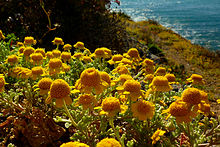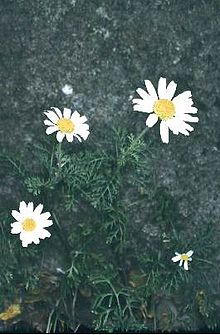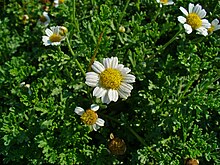Dog chamomiles
| Dog chamomiles | ||||||||||||
|---|---|---|---|---|---|---|---|---|---|---|---|---|

Field chamomile ( Anthemis arvensis ), illustration |
||||||||||||
| Systematics | ||||||||||||
|
||||||||||||
| Scientific name | ||||||||||||
| Anthemis | ||||||||||||
| L. |
The canine chamomiles ( Anthemis ) are a genus in the sunflower family (Asteraceae) with around 100 species.
description
The chamomiles are annual or perennial plants that are herbaceous or woody at the bottom. The stature heights range from 20 to 50 centimeters.
The leaves are alternate and more or less hairy. They are single or double pinnate. The sections are mostly linear-lanceolate to linear.
The baskets stand individually at the end of the stem and are medium-sized. The shell is hemispherical to funnel-shaped. The bracts are in several rows and are blunt and skin-margined. The bottom of the basket is flat or hemispherical to conical, but not hollow. The chaff leaves are lanceolate or subulate, and at the end slenderly pointed, pointed, or prickly. The baskets contain tubular and ray florets , rarely only tubular florets.
The ray florets are male or rarely sterile. The tongue is white or yellow, rarely absent. The tubular flowers are numerous, the crown is yellow. At the bottom the crown is not sagging and has no appendage.
The fruits are oblong, inverted-conical to cylindrical, in cross-section stalk-round or flattened square, clearly 10 to 20-ribbed. They have a very short, smooth-edged cardboard crown or the cardboard is missing.

Systematics and distribution
The genus Anthemis was established by Carl von Linné in 1753 . The name Anthemis was already used by the Greeks and Romans for chamomiles and dog chamomiles. The genus Anthemis belongs to the tribe Anthemideae in the subfamily Asteroideae within the family Asteraceae . As a result of molecular phylogenetic investigations, for example, the genus Cota , which was previously considered a subgenus of Anthemis , has recently been separated.
The species or subspecies occurring in Central Europe are: Field dog chamomile ( Anthemis arvensis ), Carpathian dog chamomile ( Anthemis cretica subsp. Carpatica ), smelly dog chamomile ( Anthemis cotula ), Ruthenian dog chamomile ( Anthemis ruthenica ).
There are about 100 species of anthemis :
- Anthemis aaronsohnii Eig : It occurs in Syria.
- Anthemis abrotanifolia (Willd.) Guss.
- Anthemis abylaea (Font Quer & Maire) Oberpr. : It occurs in Morocco.
- Anthemis aciphylla Boiss. : It occurs in European and Asian Turkey and in the Aegean Sea.
- Anthemis adonidifolia Boiss. : It occurs in Turkey.
- Anthemis × adulterina Wallr. ex Hallier
- Anthemis aeolica Lojac.
- Anthemis aetnensis Schouw ex Spreng.
- Anthemis alpestris (Hoffmanns. & Link) R.Fern. : It occurs in Portugal and Spain.
- Anthemis ammanthus Greuter : It occurs in Greece and Crete.
- Anthemis ammophila Boiss. & Hero. : It occurs in Turkey.
- Anthemis anthemiformis (Freyn & Sint.) Grierson : It occurs in Turkey.
- Anthemis arenicola Boiss. : It occurs in Turkey.
- Anthemis argyrophylla (Halácsy & Georgiev) Velen. : It occurs in Bulgaria.
- Field chamomile ( Anthemis arvensis L. )
- Anthemis atropatana Iranshahr
- Anthemis auriculata Boiss. : It occurs in Greece, in the Aegean Sea, in European and Asian Turkey, in Bulgaria and Macedonia.
- Anthemis austroiranica Rech. F., Aellen & Esfand.
- Anthemis ballii Stapf
- Anthemis behboudiana Rech. F. & Esfand.
- Anthemis bollei Sch.Bip.
- Anthemis bornmuelleri Stoj. & Eight.
- Anthemis bourgaei Boiss. & Reut. : It occurs in Spain.
- Anthemis boveana J.Gay : It occurs in Algeria.
- Anthemis brachycarpa Eig : It occurs in Israel.
- Anthemis brachycentra J. Gay
- Anthemis brachystephana Bornm. & Gauba
- Anthemis brevicuspis Bornm.
- Anthemis breviradiata Eig : It occurs in Syria.
- Anthemis bushehrica Iranshahr
- Anthemis caerulescens L.
- Anthemis calcarea Sosn.
- Anthemis candidissima Willd. ex explos.
- Anthemis chia L.
- Anthemis chrysantha J.Gay : It occurs in Spain and Algeria.
- Anthemis chrysoleuca J. Gay ex fish. & CAMey.
- Anthemis confusa Pomel : It occurs in Algeria, Tunisia and Libya.
- Anthemis cornucopiae Boiss. : It occurs in Syria, Jordan and Israel.
- Anthemis corymbulosa Boiss. & Hausskn.
- Smelly dog chamomile ( Anthemis cotula L. )
- Anthemis cretica L .: It occurs in three subspecies in Southern Europe, Southeastern Europe, Eastern Europe, Austria, Poland, Algeria, on the Sinai Peninsula, in Turkey, Syria, Lebanon, Armenia, Azerbaijan and Georgia.
- Anthemis cuneata Hub.-Mor. & Reese : It occurs in Turkey.
- Anthemis cupaniana death. ex Nyman : It occurs in Sicily.
- Anthemis cyrenaica Coss. : It occurs in Libya.
- Anthemis davisii Yavin : It occurs in Turkey.
- Anthemis deserticola Krasch. & Popov
- Anthemis dicksoniae Ghafoor
- Anthemis didymaea Mouterde : It occurs in Lebanon.
- Anthemis edumea Eig : It occurs in Israel and Jordan.
- Anthemis eliezrae Eig
- Anthemis emasensis Eig : It occurs in Syria.
- Anthemis filicaulis (Boiss. & Heldr.) Greuter : It occurs in Crete.
- Anthemis fimbriata Boiss. : It occurs in Turkey.
- Anthemis freitagii Iranshahr
- Anthemis fruticulosa M.Bieb.
- Anthemis fumariifolia Boiss. : It occurs in Turkey.
- Anthemis fungosa Boiss. & Hausskn.
- Anthemis gharbensis Oberpr. : It occurs in Morocco.
- Anthemis gilanica Bornm. & Gauba
- Anthemis gillettii Iranshahr
- Anthemis glaberrima (Rech. F.) Greuter : It occurs in Crete.
- Anthemis glareosa E.A. Durand & Barratte : It occurs in Tunisia and Libya.
- Anthemis gracilis Iranshahr
- Anthemis hamrinensis Iranshahr
- Anthemis handel-mazzettii Eig
- Anthemis haussknechtii Boiss. & Reut. : It occurs in southern Turkey, Syria, Lebanon, Iraq, Iran and northern Saudi Arabia.
- Anthemis hebronica Boiss. & Kotschy
- Anthemis hemistephana Boiss.
- Anthemis hermonis Eig : It occurs in Syria.
- Anthemis hirtella C. Winkl.
- Anthemis homalolepis Eig
- Anthemis homogamos (Maire) Humphries
- Anthemis hyalina DC.
- Anthemis hydruntina H. Groves : It occurs in Italy.
- Anthemis indurata Delile
- Anthemis iranica Parsa
- Anthemis ismelia Lojac. : It occurs in Sicily.
- Anthemis kandaharica Iranshahr : It occurs in Afghanistan and Pakistan.
- Anthemis karacae Güner : It occurs in Turkey.
- Anthemis kermanica Parsa
- Anthemis kitaibelii Spreng. : It occurs in Hungary and Romania.
- Anthemis kotschyana Boiss.
- Anthemis kruegeriana Pamp. : It occurs in Libya.
- Anthemis laconica Franzén : It occurs in Greece.
- Anthemis leptophylla Eig
- Anthemis leucanthemifolia Boiss. & Blanche
- Anthemis leucolepis Eig
- Anthemis lithuanica (DC.) Better ex Trautv. : It occurs in Ukraine, European Russia and Belarus.
- Anthemis lorestanica Iranshahr
- Anthemis macedonica Boiss. & Orph. : It occurs in Serbia, Macedonia, Bulgaria and northeastern Greece.
- Anthemis macrotis (Rech. F.) Oberpr. & Vogt : It occurs in Crete, in the Aegean and in Turkey.
- Anthemis maris-mortui Eig
- Anthemis maritima L .: It occurs in Spain, southern Portugal, France, Italy, Algeria, Tunisia and Libya.
- Anthemis maroccana Batt. & Pit. : It occurs in Morocco.
- Anthemis marshaliana Willd.
- Anthemis mauritiana Maire & Sennen : It occurs in Morocco and Algeria.
- Anthemis mazandaranica Iranshahr
- Anthemis melampodina Delile
- Anthemis melanacme Boiss. & Hausskn. : It occurs in Turkey and Syria.
- Anthemis meteorica Hausskn. ex Nyman
- Anthemis micrantha Boiss. & Hausskn.
- Anthemis microcephala (Schrenk) B. Fedsch.
- Anthemis microlepis Eig
- Anthemis microsperma Boiss. & Kotschy : It occurs in Egypt and on the Sinai Peninsula.
- Anthemis mirheydari Iranshahr
- Anthemis moghanica Iranshahr
- Anthemis monilicostata Pomel : It occurs in Morocco and Algeria.
- Anthemis muricata (DC.) Cast. : It occurs in Sicily.
- Anthemis nabataea Eig : It occurs in Israel and Jordan.
- Anthemis × ochroleuca L.F. Čelak.
- Anthemis odontostephana Boiss. : It occurs in Iran, Iraq, Afghanistan, Pakistan and the United Arab Emirates.
- Anthemis orientalis (L.) Degen : It occurs in Greece, in the Aegean Sea and in European and Asian Turkey.
- Anthemis parnassica (Boiss. & Heldr.) R. Fernandes
- Anthemis parthenioides Benth. ex Hornem.
- Anthemis parthenoides Bernh.
- Anthemis parvifolia Eig : It occurs in Turkey, the Aegean Sea, Cyprus and Israel.
- Anthemis patentissima Eig : It occurs in Turkey, Syria and Lebanon.
- Anthemis pauciloba Boiss.
- Anthemis pectinata Bory & Chaub.
- Anthemis peduncularis Benth. & Hook. f. ex BDJacks.
- Anthemis pedunculata Desf. : It occurs in four subspecies in Morocco, Algeria, Tunisia and Spain.
- Anthemis peregrina L .: It occurs in Italy, Sicily, Malta and Greece.
- Anthemis persepolitana Boiss.
- Anthemis persica Boiss.
- Anthemis pindicola Heldr. ex Halácsy
- Anthemis plebeia Boiss. & Noë
- Anthemis plutonia Meikle : It occurs in Cyprus.
- Anthemis pseudocotula Boiss.
- Anthemis pulvinata Brullo, Scelsi & Spamp.
- Anthemis punctata Vahl : It occurs in two subspecies in Algeria and Tunisia.
- Anthemis pungens Yavin : It occurs in Turkey.
- Anthemis rascheyana Boiss.
- Anthemis retusa Delile
- Anthemis rhodensis Boiss. : It occurs in the Aegean Sea.
- Anthemis rhodocentra Iranshahr : It occurs in Iran, Afghanistan and Pakistan.
- Anthemis rigida (Sibth. & Sm.) Boiss. ex hero : It occurs in Greece, the Aegean Sea, Turkey, Crete, Cyprus and Sicily.
- Anthemis rosea Sm .: It occurs in Turkey and in the Aegean Sea.
- Anthemis rumelica (Velen.) Stoj. & Eight. : It occurs in Bulgaria.
- Ruthenian dog chamomile ( Anthemis ruthenica M.Bieb. ): It occurs in Europe and in the Middle East.
- Anthemis sancti-johannis Stoj., Stef. & Turrill : It occurs in southwestern Bulgaria.
- Anthemis saxatilis DC. & Lam.
- Anthemis scariosa Banks & Sol.
- Anthemis schizostephana Boiss. & Hausskn.
- Anthemis scopulorum Rech. F. : It occurs in Greece, the Aegean and Crete.
- Anthemis scrobicularis Yavin
- Anthemis secundiramea Biv. : It occurs in France, Corsica, Menorca, Sardinia, Sicily, Malta, Algeria, Tunisia, Italy and Lebanon.
- Anthemis sheilae Ghafoor & Al-Turki
- Anthemis sintenisii Freyn : It occurs in Turkey.
- Anthemis sterilis Steven : It occurs in Ukraine.
- Anthemis stiparum Pomel : It occurs in Morocco and Algeria.
- Anthemis straussii Bornm.
- Anthemis subcinerea (Rouy) Rouy
- Anthemis susiana Nábělek
- Anthemis taubertii E.A. Durand & Barratte : It occurs in Libya.
- Anthemis tenuicarpa Eig : It occurs in Jordan.
- Anthemis tenuiflora Gilli
- Anthemis tenuiloba (DC.) Stoj. & Eight.
- Anthemis tenuisecta Ball : It occurs in Morocco.
- Anthemis tigrensis J.Gay ex A.Rich.
- Anthemis tomentella Greuter : It occurs in Crete.
- Anthemis tomentosa Boiss. : It occurs in Greece, in the Aegean Sea, in European and Asian Turkey and in Cyprus.
- Anthemis tricolor Boiss. : It occurs in Cyprus.
- Anthemis tricornis Eig : It occurs in Turkey.
- Anthemis tripolitana Boiss. & Blanche : It occurs in Syria and Lebanon.
- Anthemis Trotskiana Claus
- Anthemis tubicina Boiss. & Hausskn.
- Anthemis ubensis Pomel : It occurs in Algeria and Tunisia.
- Anthemis urvilleana (DC.) Sommier & Caruana
- Anthemis virescens Velen. : It occurs in Bulgaria.
- Anthemis wallii Hub.-Mor. & Reese : It occurs in Turkey.
- Anthemis Werneri Stoj. & Eight. : It occurs in Greece.
- Anthemis wettsteiniana Hand.-Mazz.
- Anthemis xylopoda O.Schwarz : It occurs in Turkey.
- Anthemis yemensis Podlech
- Anthemis zaianica Oberpr. : It occurs in Morocco.
- Anthemis zoharyana Eig
The following no longer belong to the genus Anthemis :
- High dog chamomile ( Cota altissima (L.) J. Gay , Syn .: Anthemis altissima L. )
- Austrian dog chamomile ( Cota austriaca (Jacq.) Sch. Bip. , Syn .: Anthemis austriaca Jacq. )
- Cota palaestina Kotschy , Syn .: Anthemis palaestina (Kotschy) Boiss.
- Dyer's chamomile ( Cota tinctoria (L.) J. Gay , Syn .: Anthemis tinctoria L. )
- Trionfettis dog chamomile ( Cota triumfettii (L.) J. Gay , Syn .: Anthemis triumfettii (L.) DC. )
swell
literature
- Siegmund Seybold (Ed.): Schmeil-Fitschen interactive . CD-ROM, version 1.1. Quelle & Meyer, Wiebelsheim 2002, ISBN 3-494-01327-6 .
- Rosette Mercedes Saraiva Batarda Fernandes : Anthemis L. In: TG Tutin, VH Heywood, NA Burges, DM Moore, DH Valentine, SM Walters, DA Webb (eds.): Flora Europaea . Volume 4: Plantaginaceae to Compositae (and Rubiaceae) . Cambridge University Press, Cambridge 1976, ISBN 0-521-08717-1 , pp. 145–159 (English, limited preview in Google Book Search).
- Werner Greuter, Eckhard von Raab-Straube (eds.): Med-Checklist. A critical inventory of vascular plants of the circum-Mediterranean countries . Vol. 2: Dicotyledones (Compositae) . Organization for the Phyto-Taxonomic Investigation of the Mediterranean Area (OPTIMA), Genève 2008, ISBN 978-2-8279-0011-4 , pp. 21-36 .
- Werner Greuter: Compositae (pro parte majore): Anthemis . In: Werner Greuter, Eckhard von Raab-Straube (ed.): Compositae. Euro + Med Plantbase - the information resource for Euro-Mediterranean plant diversity. Berlin 2006–2009.
Individual evidence
- ↑ Rosette Mercedes Saraiva Batarda Fernandes: Anthemis L. In: TG Tutin, VH Heywood, NA Burges, DM Moore, DH Valentine, SM Walters, DA Webb (ed.): Flora Europaea . Volume 4: Plantaginaceae to Compositae (and Rubiaceae) . Cambridge University Press, Cambridge 1976, ISBN 0-521-08717-1 , pp. 145–159 (English, limited preview in Google Book Search).
- ↑ a b Christoph Oberprieler, Sven Himmelreich, Robert Vogt: A new subtribal classification of the tribe Anthemideae (Compositae). In: Willdenowia. Volume 37, No. 1, 2007, pp. 89-114, DOI: 10.3372 / wi.37.37104 .
- ^ A b Manfred A. Fischer, Wolfgang Adler, Karl Oswald: Excursion flora for Austria, Liechtenstein and South Tyrol . 2nd, improved and enlarged edition. State of Upper Austria, Biology Center of the Upper Austrian State Museums, Linz 2005, ISBN 3-85474-140-5 .
- ^ Rudolf Schubert , Klaus Werner, Hermann Meusel (eds.): Exkursionsflora for the areas of the GDR and the FRG . Founded by Werner Rothmaler. 13th edition. tape 2 : vascular plants . People and knowledge, Berlin 1987, ISBN 3-06-012539-2 .
- ↑ Enter the taxon in the search mask for The Global Compositae Checklist .
- ↑ a b c d e f g h i j k l m n o p q r s t u v w x y z aa ab ac ad ae af ag ah ai aj ak al am an ao ap aq ar as at au av aw ax ay az ba bb bc bd be bf bg bh bi bj bk bl bm bn bo bp bq br bs bt bu bv bw bx by bz ca Werner Greuter (2006+): Compositae (pro parte majore). - In: W. Greuter & E. von Raab-Straube (eds.): Compositae. Euro + Med Plantbase - the information resource for Euro-Mediterranean plant diversity. Datasheet Anthemis In: Euro + Med Plantbase - the information resource for Euro-Mediterranean plant diversity.
- ↑ a b c d e f Anthemis in the Germplasm Resources Information Network (GRIN), USDA , ARS , National Genetic Resources Program. National Germplasm Resources Laboratory, Beltsville, Maryland. Retrieved January 12, 2019.
- ↑ a b c Flora of Pakistan. Anthemis -online .
- ^ A b Werner Greuter, Eckhard von Raab-Straube (Ed.): Med Checklist. A critical inventory of vascular plants of the circum-Mediterranean countries . Vol. 2: Dicotyledones (Compositae) . Organization for the Phyto-Taxonomic Investigation of the Mediterranean Area (OPTIMA), Genève 2008, ISBN 978-2-8279-0011-4 .




